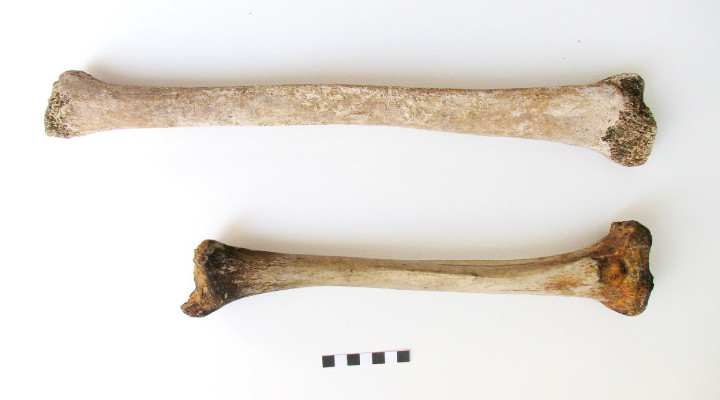Gigantism, or abnormal growth, is a sporadic disease. This disease occurs when the body of a child or teenager produces a large amount of growth hormone and causes a significant increase in height. Although gigantism is treatable, early diagnosis is essential to prevent excessive height gain and side effects. How can gigantism be diagnosed, and what are its complications and treatment? Stay with us until the end of the article to answer these questions.
Growth process and gigantism
The pituitary gland is a small endocrine gland located at the base of the brain, under the hypothalamus. This gland secretes eight essential hormones, including growth hormone. Growth hormone or somatotropin is a type of natural hormone that affects many parts of the body, including the growth plate (epiphysis) in the bone, and causes the growth and height of the child.
The release of sex hormones (estrogen and progesterone) increases dramatically during puberty, and the growth plates close slowly. At the end of puberty, growth stops with the complete closure of the growth plates. In this situation, growth hormone helps maintain bones, cartilage, organ structure, and metabolism instead of increasing height. On the other hand, growth hormone is closely related to insulin-like growth factor-1 (IGF-1), a hormone secreted by the liver. These hormones work together to regulate growth and metabolic functions.
A child’s growth rate and final height depend on various factors, including genetics, environmental factors, and gender. Gigantism causes the child to increase and be taller than peers of the same age and gender. But gigantism can be difficult for parents to diagnose because the symptoms of gigantism may seem like regular growth spurts in childhood.
What is the cause of gigantism?

Gigantism disease, also called pediatric acromegaly or pituitary gigantism, is a rare disease caused by excessive secretion of growth hormone or GH. The pituitary gland naturally produces growth hormone, but a tumor (macroadenoma) in the pituitary gland or enlargement of the gland (hyperplasia) can cause excessive secretion of this hormone, resulting in excessive growth of the child.
Most children with gigantism have a genetic mutation that causes a pituitary tumor. Most of the modifications related to this disease occur in the AIP gene. By increasing the growth hormone amount, gigantism accelerates muscle, bone, and connective tissue growth, which causes abnormal height and changes in several soft tissues. Some people with untreated or uncontrolled gigantism are taller than 2 meters. For this reason, early diagnosis and treatment of gigantism are essential. Gigantism is more common in boys than girls.
The difference between acromegaly and gigantism
Both diseases are caused by the production of excess growth hormone, with the difference that acromegaly occurs in adults and gigantism occurs in growing children and adolescents. In fact, in children, additional growth hormone is produced before the bone growth plate closes (before the end of puberty). As the growth plate closes, excess growth hormone affects the bone shape, organ size, and proper function instead of height. This disease, also called gigantism in adulthood, was caused in childhood. But acromegaly occurs after puberty. Although acromegaly is a rare disease, it is more common than gigantism.
| gigantism | acromegaly | |
| age of onset | Childhood, before puberty | Adulthood, after puberty |
| the reason | Pituitary and non-pituitary tumors | Pituitary tumors or similar diseases such as McCain-Albright syndrome |
| Main symptoms | Tall height, size of limbs, and facial features | Large limbs and facial features |
| Beginning of puberty | delayed | ordinary |
| Progression of symptoms | quick | slowly |
| diagnosis | Clinical examination, imaging, blood test | A clinical study, imaging, blood test |
| Preferred treatment | Tumor removal surgery | Tumor removal surgery |
The underlying factors of gigantism
Gigantism may be part of several rare genetic disorders that increase the likelihood of developing growth hormone-secreting pituitary tumors. These disorders include:
- Carney complex: a rare disease that affects skin color and causes tumors in the skin, heart, and endocrine glands.
- McCain-Albright syndrome: a genetic disease that affects the bones, skin, and endocrine system.
- Multiple Endocrine Neoplasia Type 1 or 4: A genetic disease that causes one or more endocrine glands to become overactive, which may include the pituitary gland.
- Neurofibromatosis: This disease is part of a genetic problem called neurofibromatosis that affects the nerves and skin.
- Familial isolated pituitary adenoma or FIPA ( FIPA) is a genetic disease that causes pituitary adenoma formation.
Symptoms of gigantism
The main symptom of gigantism is excessive growth and rapid growth. Also, a tumor in the pituitary gland may put pressure on the brain and nearby tissues and cause specific symptoms. Some of the signs of gigantism are:
- Enlargement of internal organs, especially the heart;
- profuse sweating;
- diplopia and lateral vision problems;
- headache ;
- joint pain;
- delayed puberty;
- Menstrual irregularity ;
- sleep problems such as sleep apnea ;
- muscle weakness;
- Prominent forehead and jaw;
- the distance between the teeth;
- thickening of facial features;
- very soft hands;
- thickening of boys’ voices;
- greasy skin;
- Enlargement of hands and feet and thickness of fingers.
If your child has these symptoms, it is better to talk to the doctor.
Complications of gigantism
Long-term complications of gigantism include:
- movement problems caused by muscle weakness;
- arthritis ;
- peripheral neuropathy;
- Heart enlargement and heart valve problems;
- Thyroid cancer;
- high blood pressure ;
- hypothyroidism;
- colon polyps;
- metabolic issues such as type 2 diabetes ;
- Difficulty doing daily activities, shopping for clothes, or traveling due to being taller than others.
Diagnosis of gigantism

It may be challenging to diagnose gigantism due to the rarity of this disease or the difference in the growth rate of children. In general, when a child’s height is three standard deviations higher than the normal average height for his sex and age or two standard deviations more elevated than the middle adjusted for the size of his parents, the doctor suspects gigantism and may refer you to an endocrinologist. According to the child’s medical and family history, the endocrinologist diagnoses the disease through clinical evaluations and special tests such as blood tests and imaging.
Gigantism diagnosis tests
- Blood test for growth hormone and insulin-like growth hormone 1: high amount of these hormones in the blood indicates gigantism.
- The glucose tolerance test determines whether the child’s growth hormone levels respond appropriately to glucose. For this purpose, the child’s blood samples are checked at different intervals after drinking the glucose solution.
- Imaging: If the blood test confirms gigantism, the doctor may order an MRI or CT scan to determine the pituitary tumor’s size and location and the appropriate treatment.
After confirming that a child has gigantism, other tests may be prescribed to check the effect of the disease on different parts of the body, including:
- echocardiogram to prevent heart problems;
- sleep test to check for sleep apnea;
- X-ray or DEXA to check bone health.
Treatment of gigantism
Treatment of gigantism is done with different goals, including:
- regulation of growth hormone and insulin-like growth factor 1;
- inhibition of pituitary tumor growth;
- reducing the effect of the pituitary tumors on nearby structures such as brain tissue or optic nerve;
- They are treating or reducing the effect of growth hormones on the body system.
The doctor usually uses a combination of surgery or radiation therapy treatments.
1. Gigantism surgery
Surgery is the most common treatment option for gigantism. The goal is to remove or reduce the size of the pituitary tumor. Since the size of the cancer is usually prominent in children with gigantism, several surgeries are typically needed to remove it and adjust the growth hormone. For this purpose, the surgeon may use transsphenoidal surgery and enter the intended site through the nasal passage.
2. Radiation therapy for gigantism
When surgery is impractical, radiation therapy can help reduce growth hormone levels. Radiation therapy is used as a unique tool to target the tumor. This method has several courses of treatment that are done at intervals and may last for several years.
3. drug therapy
There are drugs to treat acromegaly, but their effectiveness in children is unknown. However, some medications can help reduce growth hormone levels and are used in some cases, including:
- the high amount of growth hormone after surgery;
- impossibility of surgery;
- Trying to shrink the tumor before surgery.
There are various medications to regulate growth hormones, including:
- somatostatin analog;
- dopamine agonist ;
- Growth hormone receptor antagonist.
Possible side effects of gigantism treatment
About 60% of people with gigantism suffer hypophysis after treatment. Due to this disease, some or all of the pituitary hormones are not produced. Hypothyroidism is treated with hormone-replacement drugs.
Surgical complications of pituitary tumor removal
- bleeding ;
- cerebrospinal fluid leakage;
- meningitis ;
- Imbalance of water and salt in the body.
Possible side effects of radiation therapy
- fertility disorder;
- vision loss or brain damage (rare);
- Tumor growth several years after treatment (rare).
Prevention of gigantism
Although early detection is essential, there is no way to prevent gigantism. Timely treatment can help prevent or reduce height changes. Late diagnosis of the disease brings more side effects.
you say
How familiar are you with gigantism and its complications? Does anyone around you suffer from this disease? You can share your experience and opinion in the comments section and send this article through social networks to inform your friends.
Warning! This article is only for educational purposes; to use it, it is necessary to consult a doctor or specialist.



